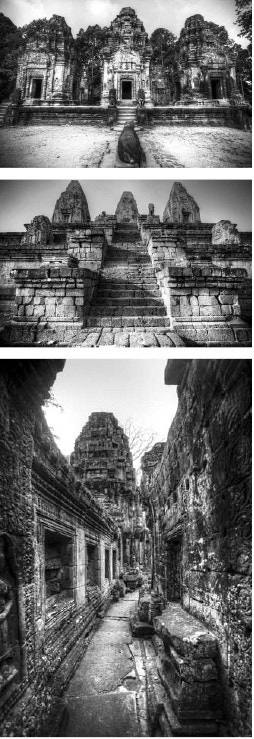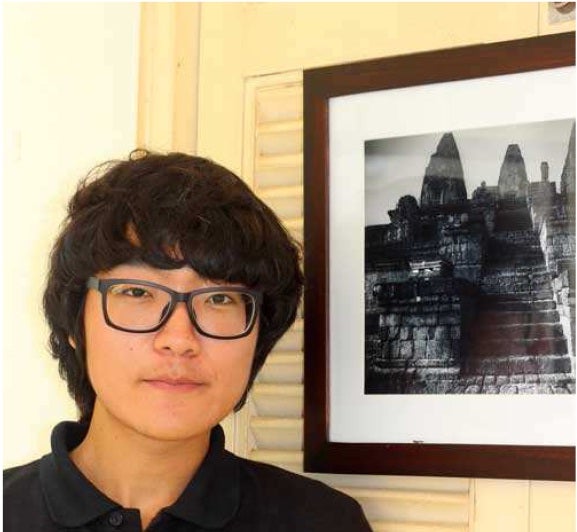20살 한국 청년이 캄보디아 시엠립에서 사진전시회 관련 프놈펜포스트 신문 인터뷰 기사
지난 4월 13일 부터 여기 캄보디아 시엠립에 20살 한국 청년이, 약 한 달간 앙코르 유적지 일대를 찍은 사진을 시엠립 시내 FCC Angkor 호텔에서 전시를 하고 있습니다.
이미 다른 분이 그 관련 내용을 글 올린 적이 있었습니다만, 이번에 캄보디아 영자 신문 중 유력 일간지인 Phnom Penh Post에서 인터뷰를 한 기사가 나왔네요.
영문으로 된 기사이니 뭐 그냥 대강 훓어 보기나 하시지요.
작품 사진 몇 장도 나와 있으니 한번 구경이나 하시구요.
아, FCC 호텔측 요청으로 전시기간이 이번 5월 말로 연장 되었다고 하니까. 5월 말 전에 시엠립으로 여행 오시는 분 있으면 FCC 호텔 구경도 할 겸, 지친 걸음 쉬면서 생맥주도 한잔 할 겸해서 들러 보셔도 좋을 것 같습니다.
사진은 다 흑백사진입니다.
Last Updated on 03 May 2013 By Miranda Glasser
Siem Reap Insider
Siem Reap Insider
KOREAN PHOTOGRAPHER DEBUTS HIS WORK AT FCC
20-year-old photographer Park JungMin. Photograph: Miranda Glasser/Phnom Penh Post
Until a month ago, twenty-year-old Park Jung Min had never travelled outside of Korea. Now the young photographer has his first ever overseas exhibition at FCC Angkor, titled Luminous in Nokor.
The exhibition, which features twenty-five black and white photos of the Angkor temples, came about quite
spontaneously. Park says he arrived in Siem Reap with no plan apart from a long-held dream to show his photography in Southeast Asia. Having spent a week or two documenting the temples of Angkor Wat and beyond, he approached FCC management who were impressed enough to agree to show his work.
The inspiration behind Luminous in Nokor is “light from darkness”, or hope from a tragic past. Park explains that the word ‘Nokor’is an old Khmer word for ‘city’ or ‘capital.’
“The focus here is the luminous, the light from the darkness. The light is from the dark history of Cambodia,” he says. “It is very positive. But at the same time I want to try and show the value. There is tragedy and terrible history however there is also light.”
The moody, monochrome pictures are shot in and around Angkor Wat, Angkor Thom and the Roulos complex. Park
photographed early in the morning and after sunset to avoid the tourists, and the results are striking. His favourite shot is of Preah Rup, with dappled sunlight and shadow falling across the ancient stone staircase.
The photos are grouped according to whether they are exterior or interior shots, with the former being displayed around the open balcony area of the first-floor restaurant.
The exhibition, which features twenty-five black and white photos of the Angkor temples, came about quite
spontaneously. Park says he arrived in Siem Reap with no plan apart from a long-held dream to show his photography in Southeast Asia. Having spent a week or two documenting the temples of Angkor Wat and beyond, he approached FCC management who were impressed enough to agree to show his work.
The inspiration behind Luminous in Nokor is “light from darkness”, or hope from a tragic past. Park explains that the word ‘Nokor’is an old Khmer word for ‘city’ or ‘capital.’
“The focus here is the luminous, the light from the darkness. The light is from the dark history of Cambodia,” he says. “It is very positive. But at the same time I want to try and show the value. There is tragedy and terrible history however there is also light.”
The moody, monochrome pictures are shot in and around Angkor Wat, Angkor Thom and the Roulos complex. Park
photographed early in the morning and after sunset to avoid the tourists, and the results are striking. His favourite shot is of Preah Rup, with dappled sunlight and shadow falling across the ancient stone staircase.
The photos are grouped according to whether they are exterior or interior shots, with the former being displayed around the open balcony area of the first-floor restaurant.
 “Outside we have panoramic views,” says Park. “Micro views are inside.”
“Outside we have panoramic views,” says Park. “Micro views are inside.”Luminous in Nokor is actually part of a five country tour. The quietly confident Park plans to show four different exhibitions in four countries, each with its own unique theme.
The fifth and final exhibition will be in Seoul, comprising all four collections.
His next destination will be Ho Chi Minh City and Hanoi, followed by Vientiane, Chiang Mai and Bangkok.
“At the end I will come back to my homeland, Korea,” he says. “In Korea I will open a huge exhibition – this is Cambodia, this is Vietnam, this is Laos, this is Thailand.”
In terms of subjects and exhibition venues, Park takes a laidback approach preferring not to plan too much until he arrives at his location.
“I can change the subject,” he says. “There is a lot of information. However as a photographer, I need my eye, I need to be inspired. I don’t want any existing information, all the subjects have to come from inside.”
Taking pictures for over two years, Park sought solace in photography while he was at high school, seeing it as an escape from the rigorous education regime.
“In the Korean education system all the mothers, fathers and teachers push you: you must only study, study, study because you have to go to a first-class university,”he says. "There is no free time. During my time studying at high
school I probably looked like a bad student, not following people’s advice. My life is photography.”



